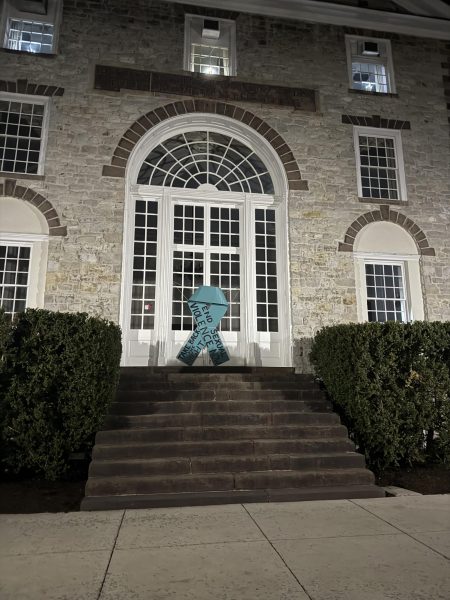Study Finds Deficiencies in Campus Facilities
A study commissioned by Dickinson College has found “deficiencies in the HUB, ATS, Athletics, The Arts, [and] Student Gathering Spaces,” with plans having been made, currently in varying stages of detail, to renovate these spaces to better utilize them. According to Associate Vice President of Sustainability and Facilities Planning Ken Shultes, the HUB, specifically the dining hall, are top priorities for modernization. However, these plans are complicated by the presence of asbestos in the HUB, amongst other campus buildings, adding significantly to the cost of any planned renovations.
The study, commissioned during the Spring 2019 semester, noted that academic spaces on campus are generally well used, but that they are currently underutilized, with room for efficiency improvements. 18 percent of floor space in campus buildings is devoted to professor and administrative offices, with classrooms and laboratory spaces comprising nine and ten percent respectively. However, emphasis is drawn to student spaces as a current priority of the college. In an email, Shultes explained that the HUB modernization project “has been under consideration for two years,” and that the college is still exploring options as to what will be done to renovate the building. “We commissioned the HUB and the Dining Hall design studies because of the urgent need for modernization and upgrades” Shultes added.
“This has been an ongoing discussion for the college” said Assistant Director of Student Leadership and Campus Engagement Jessee Vasold, “we’ve been in multiple looks at the HUB, and we know it’s a campus priority.”
Shultes explained that when the HUB was first built in the early 1960s, “the college was much smaller in terms of enrollment, and the building was essentially designed for a campus of 1,600 students.” However, the college has grown significantly past the designed capacity of the building, and changes in technology and operations means that the activities and offices housed in the HUB “require more space, and modernized space.” Shultes said that “the Dining Hall plays a significant role in the student experience, and the current configuration of the dining hall is outdated and requires modernization in order to achieve a greater potential.”
“From a social standpoint, [the HUB] needs more versatile social spaces” Vasold explained, “the HUB underground is great as a lounge, but it’s difficult to use it for different events.” Vasold also noted that many events make use of the Social Hall because it is largest gathering space on campus, but that the college is “trying to think creatively” on how to better use these spaces. “20 years ago, the SNAR was used as a live music space. There is a lighting system in there. Could that be updated, and if it could, would it be used,” Vasold questioned. Vasold divided the plans into two stages, those the college can “do with what we’ve got, and what [the college] do with a little investment.” Vasold noted that the college has shied away from relying on Allison to hold events “because people say it’s too far” despite it “being next to half of the housing on campus.”
Shultes explained that it is because college “resources are limited [that] we need to make the most of every dollar expended to achieve our goals.” Currently, plans exist for renovations to be carried out in three stages, with the first dealing with expanding and increasing the efficiency of the dining hall. Future plans call for relocating Mather’s Theatre and Montgomery House, but Shultes noted “until a new location for these programs and a funding source for the project is identified, it is not something that is forecasted to occur in the near term.”
However, “the plans are conceptual at this point” Shultes cautioned, explaining that the college is still working towards achieving “campus consensus for the project and to identify funding sources for the project.” The following step will be “design development, with the architects and the committee to develop detailed plans and refined cost estimates” followed by eventual construction. Shultes estimated the process “would take three to five years to complete.”
However, any planned renovations to the HUB are complicated by the presence of asbestos in the building. The study noted that the cost of remediating all asbestos located in the HUB would cost roughly $280,000. This is in addition to the other costs of renovating the structure. “The concern is not that there is asbestos there,” said Director of Compliance and Enterprise Risk Management Ashley Zink, “the concern is that, when you start to renovate a space, […] then you need to take abatement measures. Now your costs have just skyrocketed.” Zink described the approach to asbestos abatement as “if there is a space that has asbestos, […] and we are renovating that space in any way, we’re going to abate it,” rather than actively looking to remove asbestos from buildings as a primary renovation.
Zink explained that much of the asbestos currently in the HUB is located in floor tiling beneath carpets in the building. However, Zink noted that “one of the ways you can manage asbestos in place is through encapsulation,” explaining that because the asbestos tiling in the HUB is “encased in carpet, you’re fine.” Zink continued that there are situations in which asbestos “does not pose an issue to anyone.” Zink explained that asbestos abatement is done by external contractors if discovered by Facilities Management. However, the study noted that “without fail, each remediation project addressed since the study was completed have cost approximately double[d],” with the cost of the East College asbestos removal totalling 275 percent of what was expected. Zink noted however that college projects include contingency budgets to deal with such cost overruns. For the HUB, “people are pretty clear on what time period it was built in,” Zink added, “there are a lot of buildings from that time period in our inventory.”
“I don’t want to minimize this as an issue. It is a concerning subject,” Zink noted, however “we’ve identified the issues and the totality of the issue and I think the college has tried to manage this on a holistic level,” she said. Zink noted that the college has already dealt with many high priority asbestos abatements, and seeks to incorporate other abatements into future projects. Much of the remaining asbestos currently forms “the wrapping on pipes” and in some buildings, “it’s behind the walls, it is essentially encapsulated, so there is no risk.” Zink explained that the college has not acted to remove asbestos in these locations because, “the cost to abate something like that, why, why would we go about doing that sort of invasive project without really good reason? There’s really no benefit in doing it.”
The costliest building for asbestos remediation identified by the study is Allison Hall. Zink explained in a separate email that remediating asbestos from the roof of the Great Hall alone is expected to cost $300,000 to $400,000, compared to the $342,567 spent on the East College renovation and $349,000 spent on mold remediation between 2016 and 2018. The study noted that, for the mold issues, “no insurance claims submitted because we are consciously absorbing cost in order to minimize impact to insurance premiums and preserve our ability to be able to secure pollution insurance.”
“On an annual basis we address hazardous materials projects as part of our asset renewal process” added Vice President of Finance & Administration Bronté Burleigh-Jones, “these projects have not been impacted by any of the recent budget adjustments because they are included in $3.75 [million] allocated for asset renewal each year.”
“It’s been made clear is something the college would like to do,” Vasold noted “We know things need to be addressed.”





